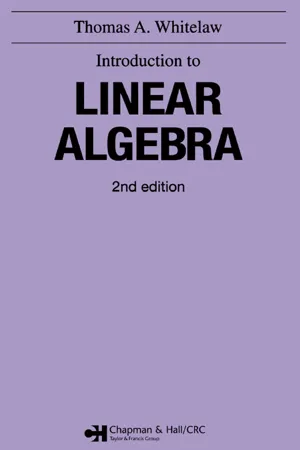
This is a test
- 288 pages
- English
- ePUB (mobile friendly)
- Available on iOS & Android
eBook - ePub
Introduction to Linear Algebra, 2nd edition
Book details
Book preview
Table of contents
Citations
About This Book
This popular textbook was thoughtfully and specifically tailored to introducing undergraduate students to linear algebra. The second edition has been carefully revised to improve upon its already successful format and approach. In particular, the author added a chapter on quadratic forms, making this one of the most comprehensive introductory te
Frequently asked questions
At the moment all of our mobile-responsive ePub books are available to download via the app. Most of our PDFs are also available to download and we're working on making the final remaining ones downloadable now. Learn more here.
Both plans give you full access to the library and all of Perlego’s features. The only differences are the price and subscription period: With the annual plan you’ll save around 30% compared to 12 months on the monthly plan.
We are an online textbook subscription service, where you can get access to an entire online library for less than the price of a single book per month. With over 1 million books across 1000+ topics, we’ve got you covered! Learn more here.
Look out for the read-aloud symbol on your next book to see if you can listen to it. The read-aloud tool reads text aloud for you, highlighting the text as it is being read. You can pause it, speed it up and slow it down. Learn more here.
Yes, you can access Introduction to Linear Algebra, 2nd edition by Thomas A Whitelaw in PDF and/or ePUB format, as well as other popular books in Mathematics & Mathematics General. We have over one million books available in our catalogue for you to explore.
Information
CHAPTER ONE
A SYSTEM OF VECTORS
1. Introduction
This textbook provides an introduction to Linear Algebra—a vast subject in its own right, and one which is useful in many parts of pure and applied mathematics. Many of the major problems discussed in linear algebra arise from systems of simultaneous linear equations and the rectangular arrays (matrices, as we call them) of coefficients occurring in such systems. It is also true that several ideas of importance in linear algebra can be traced to geometrical sources.
The contents of this first chapter are largely geometrical. The chapter uses geometrical notions to introduce a system of mathematical objects called vectors, and it shows that this system can be used to deal with various geometrical problems. In fact, however, much of the importance of the ideas of this chapter lies beyond geometry, in the essentially algebraic generalizations which these ideas admit. In particular, a later chapter (chapter 5) will introduce the concept of a vector space. This is a generalization of the idea of a system of vectors (as encountered in this chapter), and it is a concept which is very powerful and illuminating in the discussion of many problems, including those that arise from systems of linear equations and matrices. Some of the details and emphases of this first chapter are designed to prepare the way for the generalizations that come later.
For the time being, though, those generalizations lie over the horizon, and our first concern is with the motivation for studying vectors of the kind considered in this chapter. Such motivation is to be found in physics as well as in geometry. In physics there are many things (e.g. displacements, forces, magnetic fields) that have both a magnitude and a direction: we call such things vectorial quantities. Even those who claim no knowledge of physics can understand that a walk (in a straight line) from point A to point B belongs in this category because it has a magnitude (its length) and a direction (from A to B). Correspondingly, in a geometrical discussion, we may well be concerned not only with the distance between the points A and B but also with the direction of the step from A to B.
For these and other rea...
Table of contents
- Cover
- Half Title
- Title Page
- Copyright Page
- Table of Contents
- Chapter One A SYSTEM OF VECTORS
- Chapter Two MATRICES
- Chapter Three ELEMENTARY ROW OPERATIONS
- Chapter Four AN INTRODUCTION TO DETERMINANTS
- Chapter Five VECTOR SPACES
- Chapter Six LINEAR MAPPINGS
- Chapter Seven MATRICES FROM LINEAR MAPPINGS
- Chapter Eight EIGENVALUES, EIGENVECTORS AND DIAGONALIZATION
- Chapter Nine EUCLIDEAN SPACES
- Chapter Ten QUADRATIC FORMS
- Appendix MAPPINGS
- ANSWERS TO EXERCISES
- INDEX